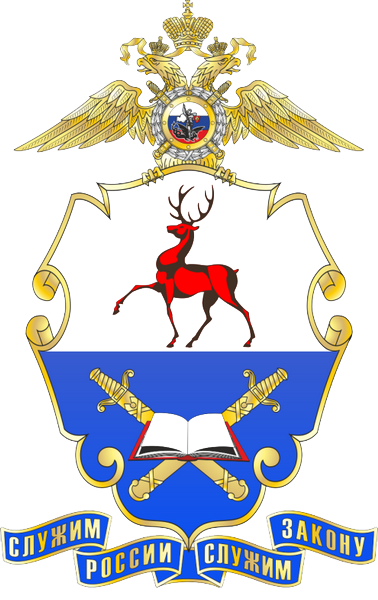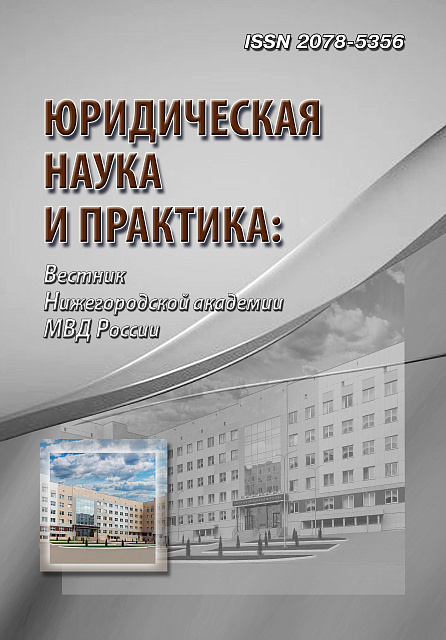National research Lobachevsky State university of Nizhny Novgorod (department of forensic expertise, associate professor)
Russian Federation
How to build such a model so that it most fully reflects a particular functional system? Probably, to answer this question, one should take into account, on the one hand, what kind of reality we are talking about, and on the other hand, what types of models and levels of modeling we have at our disposal. In this article, the author’s research focus is aimed at substantiating and proposing levels of modeling the mechanism for proving criminal activity — practical, scientific and methodological. Based on the key provisions of the theory of modeling, the purpose of models, their place and capabilities in criminology in general and in the study of the mechanism of evidence in particular is revealed.
mechanism of proof, criminal activity, model, modeling levels, methodology, patterns
1. Kolesnik I. V. Theoretical model of law enforcement technology. Dissertation... doctor of legal sciences. Nizhny Novgorod, 2015. 437 p. (In Russ.)
2. Bezrukov A. S. Legal model as a tool of legal science and practice. Dissertation... candidate of legal sciences, 2008. 151 p. (In Russ.)
3. Puchkov D. V. Criminal-legal model of protection of telecommunications from criminal attacks: problems of theory and practice. Author’s abstract... doctor of legal sciences. Ekaterinburg, 2022. 51 p. (In Russ.)
4. Vedernikova O. N. Theory and practice of fighting crime: British criminological model. Dissertation... doctor of legal sciences. Moscow, 2001. 405 p. (In Russ.)
5. Levchenko O. V. Criminal procedural activity of the prosecutor in pre-trial proceedings in a criminal case. Dissertation... doctor of legal sciences. Ulyanovsk, 2024. 698 p. (In Russ.)
6. Matushkina N. V. Forensic model of criminal activity for tax evasion and its use in order to identify and solve crimes of this type. Dissertation... candidate of legal sciences. Izhevsk, 1997. 214 p. (In Russ.)
7. Naimushin V. G. Forensic model of criminal activity in the drug business and its use in identifying and solving crimes. Dissertation... candidate of legal sciences. Izhevsk, 1998. 215 p. (In Russ.)
8. Shcherbakov A. V. Forensic model of organizing the management of criminal activity in organized criminal communities and its practical application. Dissertation... candidate of legal sciences. Izhevsk, 2004. 161 p. (In Russ.)
9. Nabokikh I. A. Forensic model of economic crimes committed on railway transport in the conditions of reform. Dissertation... candidate of legal sciences. Izhevsk, 2004. 138 p. (In Russ.)
10. Dyubova N. I. Forensic model of murder for hire as the basis for methods of solving and investigating this type of crime. Dissertation... candidate of legal sciences. Kaliningrad, 2005. 189 p. (In Russ.)
11. Mochagin P. V. Forensic model of crimes committed with the use of explosives and explosive devices, and its application for the purpose of solving crimes. Dissertation... candidate of legal sciences. Izhevsk, 2005. 133 p. (In Russ.)
12. Kurganova I. V. Forensic modeling in the investigation of crimes in the economic sphere. Dissertation... candidate of legal sciences. Nizhny Novgorod, 2008. 249 p. (In Russ.)
13. Timofeeva A. V. Forensic modeling of an unknown criminal based on the signs and properties displayed in the traces of a crime. Dissertation... candidate of legal sciences. Chelyabinsk, 2010. 184 p. (In Russ.)
14. Bayanov A. I. Information modeling in investigative tactics. Dissertation... candidate of legal sciences. Moscow, 1978. 199 p. (In Russ.)
15. Samorokovsky V. M. Forensic examination of handwriting using sign modeling. Dissertation... candidate of legal sciences. Voronezh, 1979. 263 p. (In Russ.)
16. Moiseev A. M. Theoretical foundations and methods of constructing and using optical models in forensic examination. Dissertation... candidate of legal sciences. Moscow, 1990. 215 p. (In Russ.)
17. Umaev A. A. o. The use of mathematical methods and models in the investigation of fire cases. Dissertation... candidate of legal sciences. Moscow, 1990. 289 p. (In Russ.)
18. Volchetskaya T. S. Situational modeling in crime investigation. Dissertation... candidate of legal sciences. Moscow, 1991. 192 p. (In Russ.)
19. Drobatukhin V. S. Cybernetic modeling in crime investigation. Author’s abstract... candidate of legal sciences. Moscow, 1998. 27 p. (In Russ.)
20. Logvinenko E. A. Mental modeling in investigative tactics. Dissertation... candidate of legal sciences. Krasnodar, 2003. 182 p. (In Russ.)
21. Kovalev S. A. Fundamentals of computer modeling in the investigation of crimes in the field of computer information. Dissertation... candidate of legal sciences. Volgograd, 2011. 221 p. (In Russ.)
22. Malkhanov V.V. Subject model modeling in activities to identify and investigate crimes. Dissertation... candidate of legal sciences. Chita, 2007. 222 p. (In Russ.)
23. Forensics: Textbook / answer. ed. N. P. Yablokov. 3rd ed., revised. and additional. Moscow: Yurist Publ., 2005. 781 p. (In Russ.)
24. Antonov Yu. V. Method of committing a crime against a person using a firearm. Author’s abstract... candidate of legal sciences. Izhevsk, 1995. 21 p. (In Russ.)
25. Forensics: a course of lectures / ed. prof. A. F. Lubina. N. Novgorod: Nizhny Novgorod Academy of the Ministry of Internal Affairs of Russia, 2018. 587 p. (In Russ.)
26. Zezyanov V. P. The role, place and significance of special knowledge in forensic methodology. Author’s abstract... candidate of legal sciences. Izhevsk, 1994. 24 p. (In Russ.)
27. Kaminsky A. M. Forensic content of reflexive analysis and modeling of crime detection and investigation activities in dead-end situations. Dissertation... candidate of legal sciences. Nizhny Novgorod, 1997. 173 p. (In Russ.)
28. Meretukov G. M. Legal and forensic problems of combating drug trafficking committed by organized groups. Dissertation... doctor of legal sciences. Moscow, 1995. 383 p. (In Russ.)
29. Anfinogenov A. I. Psychological portrait of a criminal, its development in the process of investigating a crime. Dissertation... doctor of psychology sciences. Moscow, 1997. 183 p. (In Russ.)
30. Volchetskaya T. S. Modern problems of modeling in criminology and investigative practice: a textbook. Kaliningrad, 1997. URL: http://biblio.crimlib.info/www/showBook.php?id=95 (access date: 06.16.2024). (In Russ.)
31. Lubin A. F. Methodology of forensic research of the mechanism of criminal activity. Dissertation... doctor of legal sciences. Nizhny Novgorod, 1997. 337 p. (In Russ.)
32. Afanasyev A. Yu. Ascent to the mechanism of criminal procedural evidence. Bulletin of the Ufa Legal Institute of the Ministry of Internal Affairs of Russia, 2019, no. 4 (86), pp. 72–81. (In Russ.)
33. Afanasyev A. Yu. The mechanism of proof as a subject of interdisciplinary research. Legal science and practice: Journal of Nizhny Novgorod academy of the Ministry of internal affairs of Russia, 2020, no. 3 (51), pp. 89–93. (In Russ.)
34. Afanasyev A. Yu., Lubin A. F., Lubin S. A. Dualism of the mechanism of evidence in criminal proceedings. Legal science and practice: Journal of Nizhny Novgorod academy of the Ministry of internal affairs of Russia, 2020, no. 2 (50), pp. 60–66. (In Russ.)
35. Afanasyev A. Yu. Private mechanisms of evidence in criminal cases. Legal science and practice: Journal of Nizhny Novgorod academy of the Ministry of internal affairs of Russia, 2023, no. 4 (64), pp. 93–99. (In Russ.)
36. Shtoff V. A. Modeling and philosophy. Moscow; Leningrad: Nauka Publ., 1966. 302 p. (In Russ.)
37. Luzgin I. M. Investigation as a process of cognition: a textbook. Moscow: Higher School of the Ministry of Internal Affairs of the USSR Publ., 1969. 176 p. (In Russ.)
38. Gustov G. A. Modeling in the work of an investigator. Leningrad, 1980. 176 p. (In Russ.)
39. Typical models and algorithms for forensic research / ed. by V. Ya. Koldina. Moscow: Moscow University Publishing House Publ., 1989. 184 p. (In Russ.)
40. Khlyntsov M.N. Forensic information and modeling in crime investigation / ed. V. G. Vlasenko. Saratov: Saratov University Publishing House Publ., 1982. 159 p. (In Russ.)
41. Amosov N. A. Modeling of complex systems. Kyiv: Naukova Dumka Publ., 1968. 88 p. (In Russ.)
42. Uemov A. I. Logical foundations of the modeling method. Moscow, “Thought” Publ., 1971. 311 p. (In Russ.)
43. Great Russian Encyclopedia. URL: https://old.bigenc.ru/philosophy/text/2221671 (accessed 06.16.2024). (In Russ.)
44. Kustov A. M. Forensic doctrine of the mechanism of crime. Dissertation... doctor of legal sciences. Moscow, 1997. 355 p. (In Russ.)
45. Lord Kelvin Baltimore lectures on molecular dynamics and the wave theory of light. London: C. J. Clay and sons; Baltimore, Publication agency of the Johns Hopkins university Publ., 1904. 703 p. (In Eng.)
46. Kelvin W. T. Structure of matter: Popul. lectures and speeches by Sir William Thomson (Lord Kelvin), D. R., Member of the Royal. islands prof. natural philosophy of the University of Glasgow / per. from English [and preface] B. P. Weinberg; ed. prof. Saint Petersburg University I. I. Borgman. Saint Petersburg: L. F. Panteleev Publ., 1895, VIII. 391 p. (In Russ.)
47. Khasanov M. M., Bulgakova G. T. Nonlinear and nonequilibrium effects in rheologically complex media. Moscow; Izhevsk: Institute of Computer Research Publ., 2003. 288 p. (In Russ.)
48. Trusov P. V., Shveikin A. I. Multilevel models of mono- and polycrystalline materials: theory, algorithms, examples of application. Novosibirsk: Publishing house SB RAS Publ., 2019. 605 p. (In Russ.)
49. Zhuravlev S. Yu. Methodological basis for improving the methodology for investigating crimes in the economic sphere. Dissertation... doctor of legal sciences. N. Novgorod, 2022. 605 p. (In Russ.)
50. Ishchenko E. P., Koldin V. Ya. Typical information model of crime as the basis of investigation methods. News of higher educational institutions. Jurisprudence, 2006, no. 6 (269), pp. 128–144. (In Russ.)
51. Zhuravlev S. Yu. Methodological problems of using forensic models of the mechanism of economic crimes in scientific and methodological work. Legal science and practice: Journal of Nizhny Novgorod academy of the Ministry of internal affairs of Russia, 2014, no. 2 (26). URL: https://cyberleninka.ru/article/n/metodologicheskie-problemy-ispolzovaniya-kriminalisticheskih-modeley-mehanizma-prestupleniy-ekonomicheskoy-napravlennosti-v (accessed 06.16.2024). (In Russ.)
52. Kharlamova O. A. Modeling methods in forensic examination: historical analysis. Forensic examination and research, 2023, no. 2, pp. 49–51. (In Russ.)












